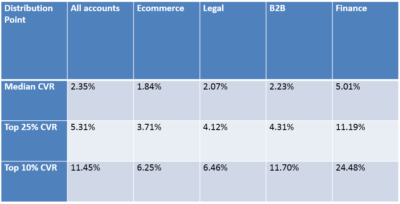Speaking of buzz words, here we have “Conversion through Web Development.” Whether you’re a start-up or an established brand, you’re probably receiving plenty of emails from companies that promise to increase your conversion rates.
So, to parse out what those mean, what they mean for you, and how to put these concepts to use, we’ve put together a handy dandy guide on conversion.
TLDR; Contents
Defining Conversion in Website Development
Your conversion rate is the percentage of your website visitors that complete a certain goal out of the total number of visitors. Your desired goal can be, for example, signing up for a newsletter or giveaway, filling out a registration form, or buying your product. Basically, any trackable call to action can be optimized for specific metrics.
The Importance of Tracking Conversion in Website Development
By tracking your conversion rates and optimizing for them (CRO – conversion rate optimization), you can determine what aspects of your website are doing well and where you’re losing people. In addition, your conversion rates allow you to measure the performance of different pages and calls to action.
A high conversion rate can also indicate your workflow is on point, your design is clear and efficient, and your calls to action are highlighted and easy to understand. Or, alternatively, the opposite. These are all essential points of information when you’re debating redesign or aiming for growth (which we all are, aren’t we?)
By having a high conversion rate, you’re also increasing your Return on Investment (ROI). How are those two related? Because if you’re budgeting a specific amount for marketing and website development and getting a higher conversion rate, you’re decreasing your cost per conversion. This yields a higher ROI on marketing and development. Win.
What’s a Good Website Conversion Rate?
So, this is a tricky question—the answer probably ranks in the top three least-liked answers, right after “No” and “Sorry, I don’t like you back.”
The answer is: it depends. A good conversion rate varies wildly between industries.
However, there are some general statistics per industry.
According to WordStream (which specializes in conversion and online marketing), the average conversion rate is 2.35%. the top 25% achieve 5.31%, and the top 10% get to 11.45%, on average.
However, if you look at industry-specific statistics, the numbers look more like this:
As you can see, the numbers do change dramatically between industries, but hopefully, these can give you some sort of benchmark.
For nonprofits, the numbers are also quite different. According to M+R Benchmarks, the average conversion rate for nonprofits’ main donation pages is 21% and varies greatly by the sector as well. However, the average conversion rate of nonprofits’ general landing pages is just under 1%.
That’s a great demonstration of user motivation, investment, and commitment. By the time visitors get to the donation page, they’re much more likely to complete the call to action. This means, most nonprofits are likely losing donations in the transition between the landing page and the donation page. Interesting, huh?
How Traction Relates to Conversion in Web Development
Traction and conversion are two peas in a pod, really. Because while conversion deals with the individual visitor, traction follows one individual user repeatedly visiting and using your website. The same factors influencing conversion—i.e., usability and fulfillment of customer needs—influence referrals and brand reputation building.
How to Optimize Your Conversion Rate in Web Development
Given your Google search about conversion, it’s likely something you’re concerned about. And you should be—it’s an essential piece of observing visitor and customer behavior. And that’s a necessary part of unlocking engagement and increasing traction, and, ultimately, purchases or donations. You know, the big bucks.
Let’s discuss factors that could influence your conversion rates and how to optimize for them.
Review Your Offer
First is the most basic premise: is your offer what your users want, and are you targeting the right people? If your conversion rates aren’t where you want them to be, it may be a good idea to review what you’re offering and see if its market fit is alright or if you’re tailoring your product to the right target market.
A/B Testing
This one’s a fun one. A/B testing tests different versions of your product, site, workflow, functionality, or even ads, to see which variations are more effective.
First, decide on which conversion behavior you’d like to investigate. Then, if there’s a problem somewhere—a specific point where you might be losing people—identify it. Next, brainstorm a list of some specific changes and solutions, and then determine how many you’d like to test at once.
Prioritization is essential here. You may want to begin with the most urgent or impactful changes, or maybe the ones that would be easiest to implement. Whatever it might be, it’s good to run a cost-benefit analysis to see which you’d like to tackle first.
Next, use an A/B testing tool to make the changes you’d like and randomly select visitors to experience different versions. The visitors who will experience the old or current version will be the control group, and those who will use the new version will be the experiment group.
Decide on how long you want to run your experiment—which depends on how long it usually takes your product or website to get a statistically significant number of conversions.
And then, analyze your results. Were the changes successful in getting your website to the desired metric? Are you now noticing other patterns that show where you’re losing or keeping users?
Designing Your Landing Page to Increase Conversion through Web Development
As we mentioned in the nonprofit example, landing pages are super significant in creating the first impression. Like that statistic that shows how viewers decide whether they will watch a Netflix show in the first 10 seconds. So your landing page is your first impression, which is why it’s critical to optimize it for conversions.
There are several ways to do this, but it’s also to remember: not all of your visitors come from the specific Google search targeted to your website. If you’re putting out paid ads, make different landing pages for visitors from various sources, who might have different motivations.
SEO
Another point on landing pages: Search Engine Optimization. For those that are coming from Google searches, it’s essential to show up in those results. So optimizing your landing pages for SEO can hugely impact your conversion rate by improving your leads.
Headers and Headlines
Your headers and headlines should, *very clearly*, present your value proposition. So, in bold (or whatever your expert design consultant suggests), highlight your users’ painpoints and how you fix them.
Fonts
Speaking of clarity, don’t use the Wingdings font. Ever. Your language should be concise and to the point, but more than that, it should be easy to read—visually. Use high-contrast colors to highlight your text and its most essential elements.
Including Customer Testimonials and Reviews
When it comes to earning a customer’s trust, customer testimonials and reviews are a close second to a personal referral. Actually—a Nielson study found that 83% of people believe that testimonials are the most reliable form of advertising. So use this to your advantage and keep your reviews front and center.
Creating a Clear, Easy Call To Action to Increase Conversion through Web Development
To increase conversion rates, keep your calls to action above the fold. And more than that, put motivating CTA language in bold with high contrast buttons that catch the eye. So, for example, “You could probably buy this, and it would be cool” is not as, how shall we say,*exciting* as “Shop Now.”
When it comes to calls to action, they also shouldn’t require too much registration or work for the user—if you’re aiming to get newsletter subscribers, keep the amount of information you ask short and to the point.
You could also incentivize with rewards—because everyone likes a discount code.
And finally, remove distractions—language on the page should be efficient, and buttons should be clear and few. Choose the most important calls to action, and don’t inundate your visitor with too many asks.
Optimizing Your Workflow
When it comes to your workflow, it’s essential to “K.I.S.A.U.I.S”: “Keep things simple and user-intuitive, sweetheart.” Workflow should be efficient, navigation should be easily accessible and on every page, and important features—such as a store or donation pages—should always be visible.
Focusing Your Efforts
So you know your users, you see who your visitors are, and you’ve done your A/B testing. Next step? Focus your efforts on the top 10% of your pages that earn 80% of your traffic. This way, you’re optimizing your website or web application for the loyal visitor and your most successful landing pages.
Making Thing Mobile Friendly
This piece is crucial. In an age where 69% of users prefer to look at reviews on their phones, your mobile version needs to be crystal clear, beautiful, and incorporate all of the elements we already mentioned.
______________________________________________________________________________________
This was a lot. We know. So, it could be beneficial to consult product strategy experts who’ll help you put the theory to the rubber.
Coincidentally, hi, we’re Goji Labs—a product and software development consultancy with experience in designing, “rescuing,” and deploying hundreds of products.
Looking to develop a new app or revamp an existing one?
Have any general questions about who we are and our authority on the subject?
Reach us at GojiLabs.com.
– Goji Labs





